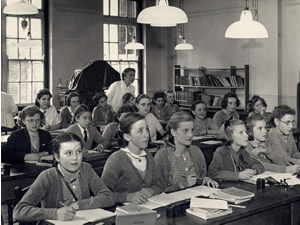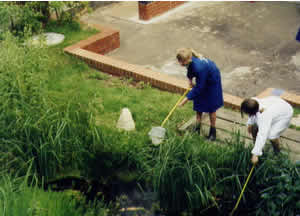|
|
|
"During the
summer the upper and
lower second went
for most enjoyable
botany walks.
"
From the 1908
school
magazine
|
|
|
|
|
|
|
"Prizes were
offered in the
summer holidays for
Nature books and
collections of
specimens"
From the 1909
school
magazine
|
|
|
|
|
| |
"I remember the
botany garden
outside the biology
laboratory. It was
divided into four
divisions for the
four orders of
flowers."
From a 1920s
pupil
|
|
|
|
|
| |
"I had a lupin
plant, for the
practical, and all
it had was these
three leaves, and
the root, there was
no flower to help me
detect that it was
leguminocae, (?) but
I knew."
From a 1920s
pupil
|
|
|
|
|
| |
"The new
biological
laboratory is
unfortunately rather
dark, but adjustable
lights have recently
been installed so
that each pair of
pupils can control
their own
illumination when
doing practical
work. There are
well-kept
‘order’
beds outside the
laboratory.
More experimental
biology work is
needed, and the
pupils should write
up their own
notes.
There is little
advanced work in the
sixth form. They are
making steady
progress but need to
be encouraged to use
the library far more
freely.
Pupils hoping
to become nurses
or social
workers have
weekly lessons
in anatomy and
physiology."
From the 1933
inspection
report
|
|
|
|
|
| |
"Her lessons
were wide ranging
and she encouraged
us to read around
the subject, eg Life
of Darwin or Marie
Curie or Pasteur.
"
From a 1930s
pupil
|
|
|
|
|
| |
"Yes, we had
“chalk and
talk” but also
a lot practical
hands on activities
with plants and
animals including
microscopes and
scalpels."
From a 1940s
pupil
|
|
|
|
|
|
|
|
|
|
To begin with, it
was all about
naming. Girls were
expected to
recognise the plants
all around them,
witness the
Wildflower
Competition, in taxonomic
detail.
There was a school
museum which
included many
biological
specimens.
They learnt plant
and animal structure
by
dissecting, and they learnt
hygiene, but sex
education was far in
the future. They did
not take Biology A
Level, but Botany
and Zoology as
separate subjects,
until as late as
1972.

1950s biology
class
After the Second
World War there was
more diversity in
the shape of field
studies at special
centres and local
venues, and a new
Sixth Form course in
Social Biology was
started.
"Social
biology is a
one-year course
for members of
the Lower VI. It
is chiefly
concerned with
the social life
of a community.
As its name
suggests it
deals with both
the biological
and the social
side of the
subjects the
course covers,
in each case
pointing out how
much more
advanced we are
in our knowledge
than our
predecessors,
and in what ways
we benefit from
it. Subjects
such as food,
clothing, house
construction,
laboursaving
devices, social
hygiene,
medicine and the
effects of a
social life on
the individual
are studied from
the aspects of
both the home
and the
community.
We have had
visits to a
bakery, a corset
factory, and the
physiotherapy
and bacteriology
departments of a
hospital."
from the 1951
magazine

Pond-dipping in
the short-lived
Biology Pond,
created outside
the Science
Block in 1995.
It was not a
natural place
for a pond, and
soon ceased to
exist.
Genetics and
molecular biology
have made huge
changes to school
biology. Nowadays
there is little
study of single
species, little
importance given to
the study of the
animal and plant
kingdoms. Instead,
the processes common
to all life are
studied, from the
building blocks
upwards, where
biology and
chemistry come
together.
Sex
education
is shared between
the Biology
department, which
explains the process
of reproduction, and
the PSHE course.
|
|
|
|
|
| |
"...she took
our class to Hayling
Island to study and
understand the way
an island can
gradually establish
itself from a sandy
beach to grasses,
shrubs and trees; it
was an interesting
exercise"
"We measured up
the beach to see
from highwater mark
where the plants
grew. It was a
fabulous day, a
glorious day, we
took sandwiches, and
we were on the beach
all day and it was
amazing how many
plants they were.
Things did grow on
Hayling beach."
From late 1940s
pupils
|
|
|
|
|
| |
"This year
Sixth Form members
spent two days
investigating the
life in a lake in
the grounds of the
Haslemere Museum.
They went in their
toughest clothes,
armed with
wellingtons,
collecting tins,
lenses, fishing
nets, reference
books and plenty of
food."
From the 1954
magazine
"There was a
pond. And somebody
broke off the one
waterlily that was
in flower.
‘Where’s
the waterlily
gone?’
"
from a 1950s
pupil
|
|
|
|
|
| |
"A party of
fifteen girls from
the LVI and UV went
to a junior meeting
of the Botanical
Society of the
British Isles at
Amberley Wild
Brooks, near
Arundel… We
arrived back at the
Town station after a
tiring but very
enjoyable day,
loaded with bottles
and polythene bags
filled with water
animals and plants,
the latter of which
had wilted somewhat,
but nevertheless
revived on reaching
the homely
atmosphere of the
biology
laboratory"
From the 1959
school
magazine
|
|
|
The Natural History
Club
|
|
| |
"…A
number of girls
thoroughly enjoyed
the dissection of
earthworms which
they had collected
themselves, and kept
in a special wormery
until needed.
Another meeting was
spent making a
microscopic study of
pond water obtained
from various sources
such as the canoe
lake…
Perhaps the
highlight of the
year was the
afternoon spent
following the nature
trail at Queen
Elizabeth Forest,
Buriton."
From the 1972
magazine
|
|
|
|
|
|
|





